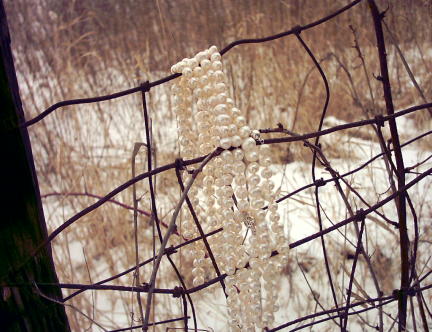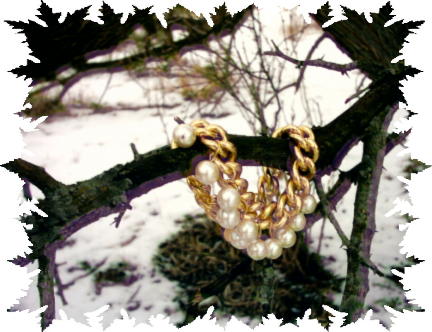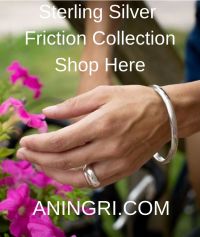|
Pearl Glossary of TermsI'll be adding to this page from time to time. If you have a related term you'd like help understanding, please contact me on the form at the bottom of the page and I'll do my best to find the answer. Thanks for visiting my glossary page.
PEARLS ON FENCE IN WINTER
NECKLACE LENGTHS for Pearl GlossaryChoker-a necklace 14-16" (35-40cm)long.Princess-a necklace 16-20" (40-50cm)long. Pendants go well on this length. Matinee-a necklace 20-26" (50-66cm) long. Sometimes a bracelet and a choker added together. Opera-a necklace twice size of a choker-28-32" (70-90cm)long. Rope-a necklace longer than opera-40"+ or 1 meter or longer. More pearl glossary terms...
PEARL GLOSSARY OF TERMSAbalone--A univalve mollusk know for its iridescent natural pearls, for its shell (used for ornamentation), and for its meat. Also known as Haliotis.Abraiaman--A fish charmer who was paid to conduct rituals and prayers on behalf of pearl divers at the old fisheries in order to protect the pearl divers from attach by sharks and other predators. Adductor--The muscle that open and closes a bivalve's shell. Akoya--A pearl from the akoya oyster (Pinctada Fucata Martensii). Ama--The diving girls in Japan who originally dove for the oysters: now a tourist attraction. Aragonite--A form of calcuim carbonate, which constitutes the nacre of the pearl.
The most valuable of baroque pearls are the South Sea and Tahitian pearls. These pearls are produced by the Pinctada margaritifera, and the Pinctada maxima (Black-lipped and White-lipped oysters). Although these are a variety of cultured saltwater pearls, the amount of time that the pearls are cultured dramatically increases the depth of the nacre, and the likelihood of producing a baroque pearl. Most Tahitian pearl farm harvests, for example, produce more than 40% baroque and semi-baroque pearls. More pearl glossary terms... Bdellium--Biblical term for a pearl. Bib--A pearl necklace of three or more concentric strands with the lowest strand a matinee or less 20-26". Bivalve mollusk--A mollusk with a pair of shells (valves) which open by means of a hinge. Biwa--A freshwater pearl grown in lake Biwi in Japan.
More pearl glossary terms...
Blister--A pearl that are attached to the inner surface of a mollusk shell. Blue--A pearl grown in Abalone mussels or a dark colored pearl found in Akoya or Silver-Lip oyster due to foreign contaminants. Bouton--A flat, round button-shaped pearl. (see Button) Bunnia--An Arab or Indian entrepreneur who financed pearl-fishing expeditions at the old fisheries of Asia and the Middle East. Button--A pearl round in circumference, but slightly flatten like a button. (see Bouton)
Calcium Carbonate--The compound from which the nacreous shell lining and crystalline calcite layer of an oyster's shell are made. Calcospherule--A natural, detached accumulation of shell material inside a mollusk, around which a pearl can form. Chicot--A hollow blister pearl. More pearl glossary terms...
Clam diver--One who dives for clams, often in the USA for pig toe clams used for nucleating pearls in Asia. At one time, not long ago, this was common in Muscatine, Iowa in the Mississippi River. Conchiolin--The first layer secreted by a mollusk to ease the discomfort caused when a foreign substance gets lodged in the mantle tissue. Usually light brownish, but can be almost black. It is a highly porous material, similar to our fingernails, and is especially important because it binds the nacre together to form the pearl. Conch--See Stombus Gigas. Conch pearls--A lovely, rare and valuable product of the giant conch, a univalve mollusk. Pink is the most desired color. The often exhibit a "flame" pattern on their surface. Crystalline Calcite--The substance that makes up the middle layer of an oyster's shell. Clutch--The rocky anchorage favored by oysters as footing. Cultured--A pearl formed after a human puts a bead nucleus or mantle tissue into a mollusk. More pearl glossary terms...
Dome--A solid blister pearl grown around a mother-of-pearl nucleus on the inside of the mollusk shell; when removed, part of the surrounding shell remains. A very distinctive looking pearl, resembling a mabe with its domed shape, but much more interesting in appearance, and much more durable. Dredge--A device dragged along the sea floor or a riverbed to harvest oysters in quantity. In the United States, dredges are known as brails. Dust Pearl--A very tiny pearl weighing a slight fraction of a grain. Epithelium--another name for mantle cells. (See mantle.) Essence D'Orient--A pearly lacquer composed of varnish and quinine from fish scales. Faux Pearl--A false pearl bead manufactured by coating the inside of a hollow glass sphere or the outside of a solid glass or plastic sphere with a pearlescent coating which is sometimes pearl powder. More pearl glossary terms...
Fine pearl--A pearl formed in the wild by the random intrusion of a natural irritant into a mollusk's shell. Also called wild pearl, natural pearl, oriental pearl. Foot--The muscle that provides a mollusk with locomotion; in many varieties the foot contains glands that secrete an adhesive substance by which the mollusk attaches itself to stationary objects. Foval--Pearlescence glass manufactured in the United States from 1901 to 1933 by the H.C.Fry Glass Company. Also know as Pearl Art Glass. Fluorescence--Normally invisible wavelengths of light that become "visible" when exposed to ultraviolet radiation. When placed under a lamp which provides ultraviolet light (these lamps provide both "long-wave" and "short-wave" radiation) you will be able to see in pearls a color or colors not seen otherwise. A gem or pearl that exhibits color under ultraviolet light--color not seen in normal light--is exhibiting "fluorescence." The color(s) of the fluorescence, and whether or not it is the same under both long-and short-wave radiation, can be helpful in identifying natural and cultured pearls. More pearl glossary terms...
Freshwater--A pearl grown in a freshwater river, lake or pond margaritifera mollusk. Often more irregular in shape and more varied in color than those from the sea. Gold-lip oyster--A large oyster (variety of Pinctada maxima) used in some countries to produce South Sea cultured pearls; it is called a "yellow lip" because it produces a yellowish nacre, and pearls that typically range from off-white to rich, deep gold in color. Grain--The standard unit of weight once used for natural pearls. Four grains are equal to one carat. Carat weight is now generally used. Quinine--Organic waste matter, similar to uric acid, that coats the scales of certain types of fish. Used to make essence d'orient. Half--A pearl that have been sanded on one side. Half-drilled--A pearl which has only been partly drilled, as for rings or earrings. These sell for more than those which are fully drilled, as those used in necklaces. Haliotis--The gastropod known commonly as the abalone. Yields very colorful, lustrous baroque pearls and mother-of-pearl, as well as edible flesh. Harlequin pearls--Untreated round Chinese freshwater cultured pearls in a variety of natural colors strung together. More pearl glossary terms... Irritant--If occurring naturally can be a minute snail, worm, fish, crab or other small particle. If introduced by man, usually a piece of mantle (membranous part that secretes nacre and covers the inner shell surface) for freshwater pearls. For those from the sea, usually the irritant is a shell bead (often from the Mississippi River) along with a bit of oyster mantle tissue. Imitation pearl--see faux pearl. Inlay--A decorative pattern of materials such as mother-of-pearl set into wood,lacquer, or another surface. Kan--A Japanese commercial unit of weight; equals 1000 momme. Kasumiga--A pearl grown in Hyriopsis Schlegelii Xhyriopsis Cumingii hybrid mussels. Generically called Kasumi. Keshi--Japanese word meaning something as tiny as you can imagine, such as a grain of sand; used originally for very tiny gems that resulted by accident as part of the culturing process; now used to refer to all-nacre baroque pearls produced when something goes wrong in the process of culturing; technically not a "natural" pearl, but virtually identical to natural baroques. South Sea keshi pearls can be very large; Japanese keshi pearls can be miniscule. Krisana--Term for pearl used in some ancient Hindu texts. La Peregrine--one of the most famous of all famous pearls is also called "Wanderer," was found in 1500 by a slave in the Gulf of Panama. Low luster--Milky, chalky appearance. Luster--The radiance of a pearl. The greater the luster the greater the value. High luster gives almost mirror-like reflections. Lugger--A large, single-masted sailing vessel, capable of carrying fifteen to twenty people, used around the old pearl fisheries. Also called a boutre. Mabe--A blister pearl which has been hollowed out and filled with a substance and backing. Majorica pearl--A high-quality faux pearl manufactured in Spain by Majorica, S.A. Mantle--Membranous tissue that secretes nacre and lines the inside of a shell.
Imitation Pearls on Tree Pearl Glossary
Margarita --Means "Pearl." Also, Margaret, Peggy, Marjorie, Margot, Maggie, Gretchen, Gretel or Rita mean this and symbolize purity, innocence and humility. More pearl glossary terms... Margaritifera--The freshwater Margaritifera mussel is used to culture freshwater pearls; the Pinctada margaritifera is a saltwater pearl-producing oyster, and the black-lip variety is used to produce naturally black color South Sea cultured pearls. There is also a white-lip and a yellow-lip variety being used in cultured pearl production. More pearl glossary terms...
Matching--Refers to a strand where the pearls relate to each other evenly, either in graduated sizes or all the same. Millimeter--A unit of measure, used to determine the diameter and overall measurements of a pearl. Approximately 1/25th of an inch. Mollusk--A member of the zoological phylum Mollusca, a category of soft-bodied invertebrates that live in shell. Mother-of pearl--The smooth inner lining of a mollusk's shell, composed of nacre. Also called pearl shell. (Also see our line of mother-of-pearl-jewelry.) Murawa, Murwari, Mirwareed--The Persian word for pearl, which translates as "child of light." source for he name Margaret. More pearl glossary terms...
Mussel-- A freshwater bivalve mollusk, usually with a drk, elongated shell. Unionides, the general term for mussels that yield especially fine mother-of-pearl, derives from the genus name,Unio. Nacre (Nay-ker)--Substance that a mollusk layers around an irritant. Natural--Pearls grown without human intervention. More valuable than cultured. Nautilus--A univalve mollusk with a chambered, spiral shell. Nucleate--To implant a nucleus in an oyster in order to stimulate the generation of a cultured pearl. Nucleus--Center. In the case of cultured sea pearls, a bead of shell, often from the Mississippi River in the USA. More pearl glossary terms...
Orient--The iridescent colors seen on or just below the surface of a pearl, because of the light reflecting within the microscopic crystals produced in the nacre. Oriental--Natural pearls found in the Persian Gulf, Red Sea, or Gulf of Mannar. Also, can refer to a pearl occurring naturally in saltwater. Orientalism--A fashion trend of the 1910's and 1920's, launched by the Paris designer Paul Poiret, which interpreted the clothing styles of Asia for European and American use. Orientalism made abundant use of pearls and faux pearls as decorative accents. Osmena--Contrarily to its name, is not a pearl, but a jewelery product derived from the innermost portion of the shell which is a pearlescent blue-gray. Oyster--A marine bivalve mollusk with a rough, irregular exterior shell and a smooth, mother-of-pearl shell lining. Paar--An oyster bank, the habitat where large numbers of oysters live close together. Also called pearl bed. Paragon--A large spherical or nearly spherical pearl weighing 100 grains or more. More pearl glossary terms...
Parure--A matched set of jewelry, which might include earrings, a necklace, brooches, rings, and other pieces. Pave--A type of jewelry in which the setting is completely covered, literally "paved," with gems such as pearls. Pearl--A nacreous growth inside a mollusk's shell, which forms around intruding irritants to protect the creature's delicate body. Pearl Age--The period during the Renaissance, roughly 1450-1650, when the immense popularity of pearls in Europe produced extravagant pearl fashions and fueled the pearl rush in Central America. Pearl Diver--A person who dives for pearl-bearing mollusks. Pearl doctor--An artisan who peels layers of nacre from blemished pearls in order to uncover a more perfect surface. Pearl Farm--An operation where oysters are bred and grown in captivity for the production of cultured pearls, and then nucleated and tended until cultured pearls are ready to be harvested. Pearl Fisheries--A site where mollusks are harvested in the wild for the purpose of finding pearls or mother-of-pearl. Pearl sac--A cyst of epithelium (mantle) tissue that surrounds an irritant inside a mollusk's shell and secretes nacre around it to form a pearl. More pearl glossary terms...
Pearlescent--Resembling pearl or mother-of-pearl in iridescence and luster. Pearling--The art and craft of pearl fishing. Pearling Camp--A makeshift settlement erected near a pearl fisher to house those engaged in pearl fishing. Pearlized--Having an artificially produced pearly appearance. Periculture--Pearl culturing or pearl farming; the practice of inducing pearl formation in oysters by inserting artificial stimuli, most often small mother-of-pearl beads. Also called pearl cultivation. Periculturist--A pearl farmer; one who engages in periculture. Periostracum--The hard outer shell of an oyster. Pinctada--Refers to the pearl-producing genus. Usually abbreviated to "P>"; for example, P.fucata would indicate the Pinctada genus and the fucata species. P.fucata--Also known as P.martensii, the oyster used to produce cultured Japanese and Chinese gems. P.maxima--A large oyster used to produce South Sea cultured gems; includes the "silver lip" which produces the silvery white varieties typical of Australia, and the "yellow lip" which can produce yellow and golden gems. More pearl glossary terms...
P.martensii--A gem-producing oyster used in Japan and China; smaller than P.maxima, capable of producing gems up to a maximum size of about 10+ millimeters. P.margaritifera--Gem-producing oyster with black, white, or golden colored "lips," producing nacre similar in color to its "lips." The black-lip variety is used in Tahiti and other parts of French Polynesia to produce natural color black cultured gems. Pinna--A Mediterranean bivalve that makes lustrous pearls that deteriorate rapidly because of their unusual crystalline structure and high water content. Also sought for its edible flesh. Pteria penquin--Mollusk used to produce mabe pearls. Rhodoid--A pearlized laminate used for tabletops and other objects. also know as French Deco Linoleum. Saltwater--One from a saltwater (ocean, sea, gulf or bay) mollusk. Seed pearls--Tiny naturals weighing under 1/4 grain, usually less than 2 millimeters in diameter. Semi-cultured--Imitation. More pearl glossary terms...
Shell carving--The practice of carving mother-of-pearl and other types of shell into figurines, trinkets, and objects d'art. Shinju--Japanese term for pearl. Soufflure--A hollow pearl, formed when an organic irritant decomposes inside its pearly coating before the nacre hardens. Gases released by the rotting object inflate the nacreous buildup like a bubble. South Sea--Two meanings: One meaning is any saltwater pearl found between Philippines and Indonesia and Australia and across to French Polynesia.
Spat--An oyster larva before it forms its shell. Stombus Giga--A large, horny univalve of the Caribbean, which has a smooth, pink interior. Produces porcelaneous, pearl-like gems and edible flesh. Commonly known as conch or great conch. Surface quality--Refers to blemishes on the surface. A strand without any blemishes is rare. Toki--pearls that have a distinct bump on the top - like little jugs. Three-quarter--pearls that have usually, because of a flaw, been sanded on one side. Tridacna--The giant clam of the South Pacific. Produces large but not particularly lustrous pearls. Unio--A genus of freshwater mussel that makes small, irregular pearls with good luster. Unionides--General term for mussels, derived from the genus name Unio. More pearl glossary terms...
Univalve--A mollusk with a one-part shell, such as a snail. Valve--The shell of a mollusk. Univalves have one valve, bivalves have two. White pearls--Pearls with basically white body color. Can range in tint from white, cream, yellow, and golden to pink, green, blue, and silver. Wild pearl--See Natural pearls. End of pearl glossary terms... Special thanks for some of the terms in this pearl glossary to Antoinette L. Matlins, PG, author of "The Pearl Book," and to Kristin Joyce and Shelly Addison, authors of "Pearls--Ornament and Obsession." Go to about pearl page after pearl glossary.
|













